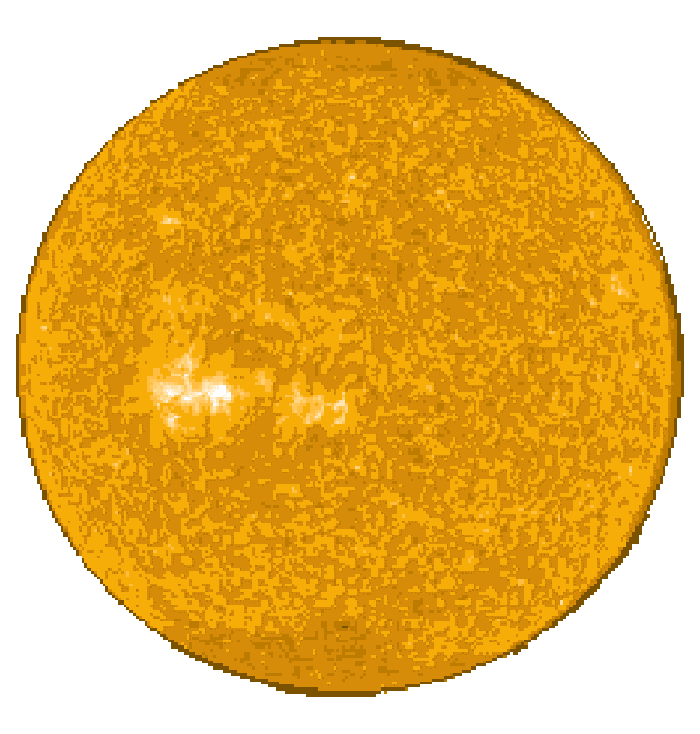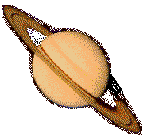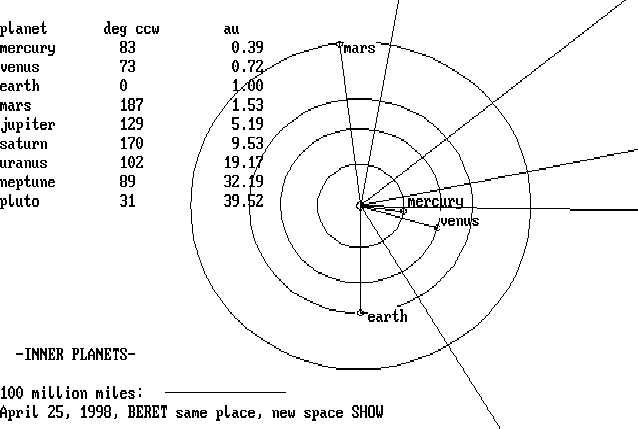 Jno Cook
Jno Cook Jno Cook
Jno Cook

installation view
This is a scale model of the solar system, accurate for April 25, 1998, at 6:00 pm of the day of the opening of Jno Cook and Mike Slattery "Same Place; New Space", at Beret International Gallery, and thus represents the natal chart for the rebirth of Beret.
See also the [Space] page for plans, and an astrological reading by Claudia George.
The sculpture consisting almost entirely of "space," since the largest object, the Sun, is only 1/4 inch in diameter. At the extreme limit of the model, 40 feet from the Sun, is Pluto -- less than 1/100th of an inch in size.
I hope that a walking tour of the solar system will allow you to gain an appreciation of the insurmountable isolation which is our lot in being bound to one planet in the vastness of this universe. You will be walking at about 1000 to 2000 times the speed of light.

with Mike Slattery's collection of fading Stars
For those who must know the actual (and mostly incomprehensible) sizes and distances, the following table is presented.
object diameter relative distance distance mass,
[miles] size from sun from sun kilograms
[million miles] [in AU] [x10exp24]
Sun 864,000 1000 -- -- 1,989,100
Mercury 3,100 4 36 0.39 0.3
Venus 7,700 10 67 0.72 4.8
Earth 7,900 10 93 1.00 5.9
Moon 2,157 3 93 1.00 0.07
Mars 4,200 5 142 1.53 0.6
Jupiter 88,700 100 484 5.19 1898.6
Saturn 72,000 80 887 9.53 568.4
Uranus 32,000 40 1,787 19.17 86.8
Neptune 31,000 40 2,797 32.19 102.4
|
The nearest star on this scale is 51 mi away.
The next galaxy on this scale is 24,000,000 mi away.


Mercury: Messenger god of the Greeks, and the angel of announcements of the Hebrews. About the size of our moon, Mercury is the Sun's moon, always keeping the same face towards the Sun in its 88 day "month," like our moon does to us. Although the fastest moving planet, the scale model would move less than one half inch per day.

Venus: Athena of some of the Greeks, and after much confusion, Venus of the Latins. Virtually the same size as the Earth, shrouded in dense clouds, and covered with active volcanoes, Venus is often the brightest object in the sky. Venus rotates backwards, that is, it is turned upside down. Galileo, with his 200 foot telescope, discovered that Venus had phases like our moon. His mother-in-law could see that with her bare eyes.

Earth: Meaning soil or dirt in northern European languages, Ge of Geography, and related names, of the Greeks. 1/100th the size of the Sun, wrapped in a thin layer of clouds, and covered with water (there are also some land areas). Tilted at a precarious 23 degrees to the plane of its orbit about the Sun, it rotates once every 24 hours. A very large and distant satellite orbits Earth once every 27 days (29.5 days as seen from Earth) at a distance of some quarter million miles.

Mars: Ariz of the Hebrews, Marut of the Hindus, taken up by Greek and Roman mythology as Ares and Mars. Since antiquity Mars has had two dogs (named Fear and Terror) chasing about the legs his war horse (or had his war chariot pulled by two steeds of these names). Two very close in and speedy satellites of Mars were discovered in 1877, and named accordingly. Mars is somewhat larger than our moon, is as badly tilted as the earth (25 degrees), and also rotates in 24 hours.

Jupiter: Jove Pater - father Jove - of the Romans, Zues of the Greeks. The largest planet, 10 times the size of Earth, rotates in an incredible ten hours. Has more mass than all the other planets put together, and represents almost all the angular momentum of the solar system. For all practical purpose our solar system is a two star system, one of which is dead. Jupiter is brighter than any star, and easy to locate in the sky. Half a dozen of its satellites can be seen with binoculars. Moves one zodiac sign each year.

Saturn: The obscure Saturnus of the Romans, my have been Cronos of the Greeks - meaning either time keeper (which actually Jupiter accomplishes), or crowned, ie, ringed. Companion to Jupiter, almost the same size and rotational speed, but is mostly a ball of gas around a small core, light enough to float on water. Crowned with rings at the equator. Circuits the Sun in 30 years. The furthest out planet known and tracked since antiquity.

Uranus: Somewhat less than half the size of Jupiter, and discovered in the 18th century, it takes 84 years to make a leisurely circuit around the Sun. Named after Father Sky of Greek creation myths (Hesiod), for he was banished by Zues, although formerly the chief god and his father. Rotates at right angles to the plane of its orbit. Looks like it had an accident.

Neptune: After the Roman Neptune, another looser in the battle of the gods. About the same size as Uranus, but almost twice as far from the Sun.

Pluto: The Roman dog of Hell. Hardly a planet, Pluto is a little larger than our moon, and travels a tilted and wildly elliptical path which crosses the orbit of Neptune. Probably Neptune's moon at one time. We had to locate Pluto by the rear elevator.


I have often been attracted to staging visual realizations of large numbers -- like visually accounting for the 50,000 nuclear warheads this country owns, or the billions of humans which will populate this earth soon. The distances, the magnitudes, and the emptiness involved in our diminutive occupation of a small parcel in an outsweeping arm of a remote galaxy, calls for a reduction of these dimensions to a physical model which, if it could be seen, might evolve in our minds some reasonable concepts about the relative magnitudes -- and their consequences.
The distances involved in our solar system are so large as to be virtually unimaginable. Stellar distances are 5 orders of magnitude larger yet.
Simulations of space travel as seen in films are generally wildly inaccurate, but they are part of popular culture, part of how we view ourselves as "in control," even of galactic distances. Stars flit by on Star Trek, yet the stars would not noticeably move even at 1000 times the speed of light.
This perception of space as conquerable and controllable results from the fact that planet sizes and interplanetary distances, and by extension the distances involved in the universe, cannot be properly imagined in our minds. Big numbers just remain meaningless big numbers.
The emptiness of space, the distances between planets, and the diminutive sizes of the planets in relationship to the sun, will remain meaningless unless they can be seen and experienced. This requires a very large scale mode -- small enough to see planet to planet distance, yet large enough so that the planet sizes do not disappear altogether from sight.
The model at Beret is probably the lower limit for such a scale model. You will still be able to see the planets -- although you will be warned that they are shown at ten to 100 times their correct size, while you are able to stroll from planet to planet at 1000 times the speed of light.
This installation was first accomplished at the South Bend Regional Museum of Art at "Ungallery," an outdoor group exhibition at the Morris Civic Auditorium Plaza in South Bend, Indiana, on July 2 - 4, 1993.
The point of the exhibit was a demonstration of the absolute vastness of space (and nearby space at that) at a time when "space travel" was a popular notion and a severe misconception induced by the excitement of "Star Wars" and furthered by a senile president and his flamboyant SDI program.
The model in South Bend was 175 feet in its largest dimension. Milliwatt lamps were used for the planets, measuring 1/16 of an inch in diameter. Even so, all of the planets could be spotted at these distances, despite sunlight, competing street lights at night, and the busyness of trees, people, and automobiles.
The model deployed for Beret's reopening is a reduction to some 39 feet. The inner planets occupy a space only 18 inches in diameter; the outer planets are spotted throughout the remaining 40 feet. The model is staged 5 inches off the floor, using the same 30 watt quartz lamp for the sun, and the milliwatt lamps for the planets as before. The relative diameters of the planets are thus much too large. But the idea of the interplanetary -- empty -- space remains as exuberant as with the previous model.
By the way, all the planets will be lined up across the sky on April 25, covering a span of about 6 houses of the zodiac -- but sunlight will prevent their viewing.
The text above is mostly lifted from the hand-out brochure "Walking Tour" presented at South Bend in 1993, updated for the event of April 25, 1998, and copyrighted by the South Bend Regional Museum Of Art.
 Aesthetic Investigation
Aesthetic Investigation